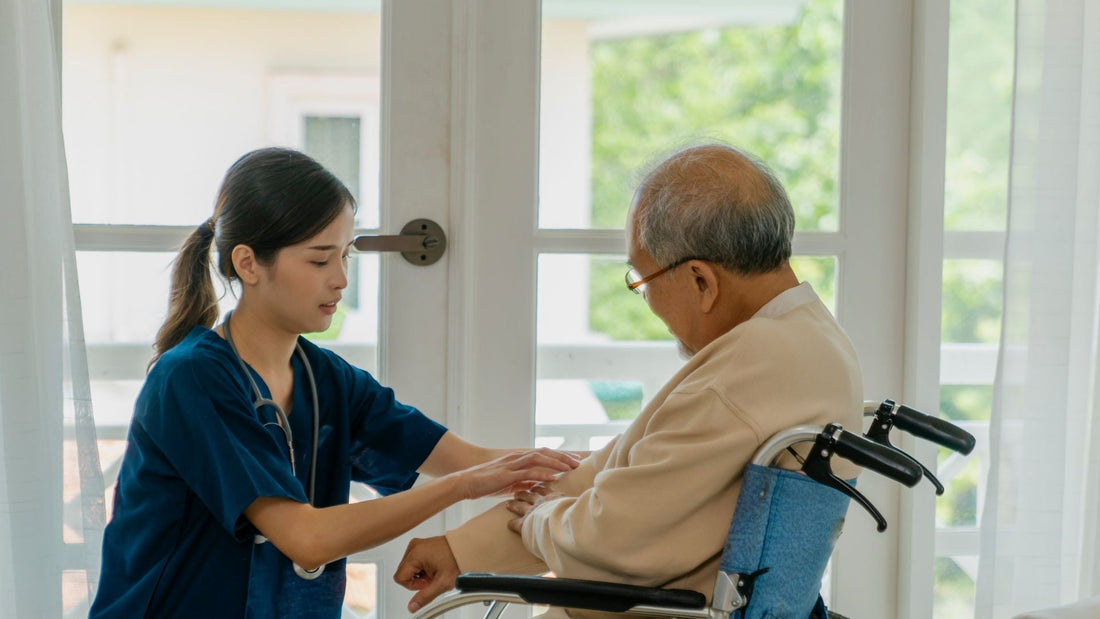
Returning to Exercise After Prostate Surgery: Managing Leaks During Physical Activity
Share
Getting back to exercise after prostate surgery feels like a frustrating catch-22. You know physical activity is important for your overall health and recovery, but the leakage that happens when you move makes you want to stay on the couch.
Here's the reality: exercise actually helps your recovery, including your bladder control. This guide shows you how to return to the activities you love without letting incontinence hold you back.
"Be sure to follow all directions given to you by your doctor(s) as this guide does not supersede their recommendations and advice."
Why Physical Activity Matters for Your Recovery
Exercise isn't just about staying fit. It's a crucial part of recovering from prostate surgery and regaining bladder control.
Physical activity strengthens your pelvic floor muscles, the same muscles responsible for controlling urine flow. When you engage your core during exercise, you're indirectly working these critical muscles. Over time, this builds the strength you need for better continence.
Beyond the physical benefits, exercise dramatically improves mental health during recovery. Depression and anxiety are common after prostate surgery, especially when dealing with incontinence. Regular physical activity releases endorphins, reduces stress, and gives you a sense of normalcy.
Staying active also prevents deconditioning. Muscle loss, weight gain, and reduced cardiovascular fitness only make your overall recovery harder. The confidence boost from successfully managing exercise with incontinence reinforces that incontinence doesn't have to define your life.
Your Timeline: When to Start Different Activities
First 6 weeks: Walking is your best friend during this phase. Start with short distances and gradually increase. Avoid lifting anything heavier than 10 pounds. No strenuous activity, cycling, or running. Your body is still healing internally.
Weeks 6-12: Get clearance from your surgeon before progressing. Once approved, you can gradually add light resistance training, swimming, and stationary cycling. Start at about 50% of your pre-surgery intensity and increase slowly. Some leakage during activity is expected.
3+ months: Most men can return to their pre-surgery activities by this point, though you may still need protective devices. Running, heavier weightlifting, and high-impact sports are usually okay after the 3-month mark with medical clearance.
Sports-specific considerations: Golf and tennis involve twisting motions that can stress healing tissues initially. Swimming is excellent low-impact cardio but plan for bathroom access. Cycling requires a well-fitted seat. Contact sports should wait until you're fully healed.
The Leakage Challenge: Why Exercise Makes It Worse
Stress incontinence is the culprit. When you cough, sneeze, lift, or jump, you're increasing abdominal pressure. This pressure pushes down on your bladder. After prostate surgery, your weakened pelvic floor can't hold against the pressure.
Exercises that cause the most leakage include jumping and plyometrics, heavy overhead lifting, running and high-impact cardio, exercises involving breath-holding while straining, and sit-ups or crunches that heavily engage the core.
This is temporary for most men. As your pelvic floor strengthens and surgical swelling resolves, you'll tolerate more intense activity without leakage. What causes significant leaks at 2 months post-surgery might be manageable with light protection at 6 months and require nothing at 12 months.
The key is staying active despite the leakage rather than waiting for perfect control before exercising.
Protective Solutions for Active Men
The right protection makes all the difference in your confidence and willingness to exercise.
For most active men, penile clamps offer the best combination of security and discreteness during workouts. They're designed to prevent leakage during exactly the kind of physical stress that exercise creates. Unlike pads, they don't shift during movement or create bulk under athletic wear. Learn more about how to choose male incontinence clamps. Many men using the Pacey Cuff for workouts report feeling more secure and confident during exercise:

Guards and pads designed for men work better than standard absorbent products. They're shaped for male anatomy and stay in place better during movement. For lighter leakage, these can be sufficient.
Athletic supporters and specialized underwear provide extra security. Some are designed specifically with pockets for absorbent products, keeping everything firmly in place during high-movement activities.
Test your chosen protection during low-stakes workouts before trying it in public gym settings.
Modified Exercises That Reduce Leakage
You don't have to avoid exercise, but you can modify movements to reduce stress on your bladder.
Instead of running, try walking with intervals of faster walking, elliptical machines that reduce impact, cycling which provides cardio without the jarring, or swimming for excellent low-impact full-body workout.
For core work that supports rather than stresses, focus on planks and modified planks, bridges which strengthen glutes and core while supporting pelvic floor, bird dogs for core stability with minimal pressure, and dead bugs which work the core gently.
When lifting weights, use proper form to minimize abdominal pressure. Breathe out during the exertion phase rather than holding your breath. Engage your pelvic floor before lifting. Start with lighter weights and higher repetitions.
Proper breathing strategies make a huge difference. Never hold your breath during exertion. Exhale during the hard part of the movement. Practice coordinating pelvic floor engagement with breathing.
Building Back Your Pelvic Floor Strength
Exercise gives you the perfect opportunity to work on pelvic floor strength in functional ways.
Exercise-specific Kegel techniques involve engaging your pelvic floor before exertion. Before you lift, jump, or cough, do a quick pelvic floor contraction. This "knack" technique has been shown to reduce leakage during activities.
During lifting, coordinate your pelvic floor engagement with the lift itself. As you prepare to lift, engage your pelvic floor, then breathe out as you lift while maintaining that engagement.
Progressive loading principles apply to pelvic floor recovery. Start with bodyweight exercises, gradually add light resistance, slowly increase weight and intensity, and allow recovery time between harder sessions.
Pelvic floor strengthening takes weeks to months, but consistent effort pays off.
Real Talk: Gym, Pool, and Group Fitness Settings
The logistics and anxiety of exercising in public settings with incontinence are real concerns.
For gym anxiety about visible leaks, remember that most leaks aren't as noticeable as they feel. Dark-colored, moisture-wicking athletic wear is your friend. Longer shirts that fall below the waist provide extra coverage.
Choosing the right workout clothes makes a difference. Avoid light gray. Compression clothing holds protection in place and provides visual smoothing. Layering gives extra security.
Bathroom access planning is practical. Scout bathroom locations when you first arrive. Choose equipment near exits or bathrooms when possible. Plan your clamp removal and bathroom breaks between exercises.
In pool settings, empty your bladder immediately before swimming. Rinse thoroughly after, as chlorine can irritate.
Group fitness classes can be modified. Tell the instructor you have a medical condition that requires modifications. Position yourself near the exit.
Success Stories: Getting Back to the Activities You Love
Real men return to the sports and activities they love after prostate surgery.
Golf: Most men return around 8-12 weeks post-surgery. Use a clamp during play. By 6 months, many golfers find they need minimal to no protection for a full 18 holes.
Cycling: Start on a stationary bike at 6 weeks, outdoor riding around 8-10 weeks. Clamps work well under cycling shorts. By 4-6 months, most cyclists are back to their regular riding schedule.
Running: Start with walk-run intervals at 8-12 weeks with good protection. Many runners find they can do short runs with protection by 6 months and longer runs by 9-12 months.
Weightlifting: Light lifting can resume at 6 weeks, progressing carefully. Most men can return to heavy lifting by 4-6 months. Clamps are popular among weightlifters for the confidence to push hard.
For comprehensive guidance on all aspects of managing incontinence after prostate surgery, check out our complete recovery guide. Here’s what users say about getting back to their favorite activities with the right support:
Frequently Asked Questions
When can I start exercising after prostate surgery?
Walking can start within days. Wait 6 weeks before lifting, running, or cycling. Always get specific clearance from your surgeon, as individual situations vary based on surgical technique.
Will exercise make my incontinence worse long-term?
No. While physical activity may cause more leaking initially, appropriate exercise actually helps long-term recovery by strengthening pelvic muscles and improving overall health.
What's the best protection for working out?
Many active men prefer penile clamps during exercise because they're secure, prevent leaks rather than absorbing them, and are less bulky under athletic wear.
Can I lift weights with urinary incontinence?
Yes, though you may need to modify technique. Avoid breath-holding and excessive straining initially. Use lighter weights with higher reps. Engage your pelvic floor before lifting.
How long until I can run again without leaking?
Most men can attempt light jogging around 8-12 weeks post-surgery with protection. Running without leaking typically takes 6-12 months. Start with walk-run intervals and progress slowly.

